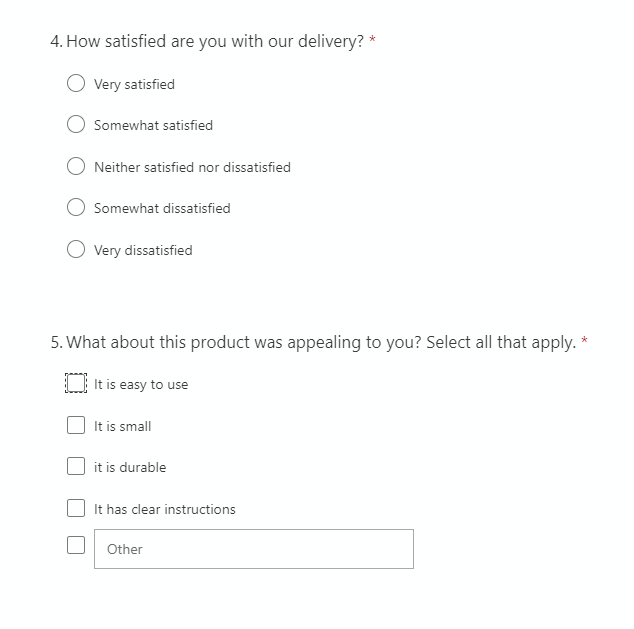Developing an effective customer response survey with Dynamics 365 Customer Voice
Gathering customer feedback is one of the most effective means to improving your company’s products and services. Successful companies—those who wish to build resilience, foster a growth-mindset, and earn and maintain customer loyalty—listen to and deliver on what their customers desire. Dynamics 365 Customer Voice is an online survey platform that can be used with Microsoft Dynamics 365 Marketing that can help any business create and manage simple, effective surveys as part of their journey toward resilience, growth, and customer loyalty.
Best practices for effective surveys
When gathering information or conducting research in any capacity, certain best practices are recommended to avoid bias and false/inaccurate data and, of course, to get as much useful data possible from those surveys.
First and foremost, surveys should be designed to achieve a specific purpose. Consider these questions when designing a survey: What is the company trying to improve right now? What questions can best glean customer experience within that aspect of the company? When in the customer’s journey is ideal to ask for this feedback? Consider surveys for targeted events in the customer’s journey as well as general experience surveys. Engaging your customer consistently will allow you to ask questions when the customer is ideally set to answer them and shows your dedication to the customer. Don’t go overboard, though.
Be brief. Be mindful of your customer’s time: they don’t have time to consider and respond to lengthy surveys. Try to keep the standard survey to a few questions.
Keep the survey questions and language simple. Uncommon or complex words, jargon, and slang should be avoided. If your field uses acronyms, either skip them altogether in favor of the full term or include the full term the first time you introduce the acronym. For example, “We recommend Dynamics 365 Business Central (BC).”
Avoid question bias, which can occur when a question is phrased or formatted in a way that skews respondents toward certain answers or when a question/answer is confusing. Usually, question bias is easy to spot: the question itself clearly indicates a preferred or “correct” response. Question bias can be caused by using emotional, leading, and/or confusing language.
Consider this example survey question: “How excellent was your experience with our customer service?” This question uses both emotional and leading language. “Excellent” has positive associations and therefore makes assumptions about the customer’s experience (that it was good). In this case, the customer is being led toward a perceived favorable response and is obligated to answer the question on a scale of how excellent the service was. This question phrasing does not allow for more objective responses. Not only can this frustrate your respondent, but your survey results may be flawed and can lead to incorrect assumptions about your customers’ experiences and needs.
Though question bias can be created intentionally (and unethically), question bias is most often an accident. To ensure your survey has no question bias, be vigilant to avoid leading, emotional, or confusing language. A further productive precaution is to establish a coworker review process of your surveys before they are used.
This is a better survey question:
Avoid subjective, vague, or ambiguous language whenever possible. The question “How good is our customer service?” will provoke varied responses, depending on what “good” means to that customer. The question “Do you think your friends would enjoy X product?” relies on the customer’s friends, if they often give recommendations, and many other variables. Each respondent will answer the second question with different thoughts in mind. Go for more specificity in questions and answers whenever possible (but don’t go overboard). More specific, less vague/ambiguous questions may include:
Keep similar types of questions/answers consistent. If you ask a respondent to answer one question on a scale of 1-10, for instance, don’t ask them to answer on a scale of 1-7 next question, and keep scale identical. Though you include instructions for questions, respondents won’t always read them as thoroughly as you would hope, and you want to eliminate as many opportunities for miscommunication and incorrect responses as possible.
Do not ask 2-in-1 questions (also known as double barreled questions) like, “On a scale of 1-10, how satisfied are you with our delivery and the product?” This question should be made into two for greater clarity and less frustration on part of the customer. Why? A customer may be very satisfied with the product, but the delivery could have taken way too long, or may be moderately satisfied with a product but really appreciated the quick delivery. The two more effective questions may become:
Stay away from questions that require directly contrasting or absolute responses. Such questions usually have 2 answers, such as yes/no or always/never. An example of a yes/no question is: “Are you satisfied with the customer service you experienced?” A respondent can struggle with these responses because they do not allow for uncertainty or middle ground. Respondents are also more likely to answer affirmatively or positively (called acquiescence bias) in these cases, further skewing your data. Allowing neutral or in-between responses, or even “Not applicable” and “Other” will avoid false data from respondents being forced to pick a response that does not fit their experience.
Particularly when a question may elicit unforeseen results, or you can think of myriad answers, you can allow “Other” or short answer responses (as shown above). This will make the survey more specific, which is great for targeting specific customers and resolving their concerns. But if you are looking for more far-reaching actionable items to implement from the survey results, this approach may not yield useful insights. (Imagine categorizing or counting all survey results for this question manually. Whether you have 100 or 1,000 respondents, this is an overwhelming task!)
Test the survey multiple times as part of your finalization. Have coworkers test the survey as well to catch any errors. Testing is particularly vital in surveys with branching, which skip or jump to questions based on the response a customer selects.
Include a thank you once the survey is submitted or send a thank you email shortly after. This is basic etiquette, but a thank you can allow for one more touchpoint with the customer to show your loyalty and appreciation. Everyone appreciates being appreciated.
Create and send surveys in Dynamics 365 Customer Voice
Dynamics 365 Customer Voice automatically implements or suggests many of the above best practices. In Microsoft’s words, Customer Voice is “an enterprise feedback management application that allows you to easily keep track of the metrics that matter most to your business.” But what does that actually mean?
Customer Voice is a survey-building platform that allows you to create and send customer surveys, after which you can manage them, view results, and create actionable items based on those results.
Customer Voice is part of the Dynamics 365 ecosystem, which is unified and adaptable. So, you can seamlessly connect Customer Voice to your customer journeys in Dynamics 365 Marketing and customer data in other Dynamics 365 applications like Customer Insights and Microsoft Power Platform. All the customer’s information and responses are in one place, so your team can be informed and act accordingly.
Customer Voice has many features and functionalities for each step of the survey process, from creation to implementation to creating actionable items based on responses. Use template surveys, such as the Periodic surveys and the Order delivery surveys, or customize a survey via its design, questions, question responses, and flow. Customizing the flow of the survey using branching rules allows surveys to be interactive and specific to each customer. For instance, if a question does not apply to a customer based on a previous response, you can structure the survey to skip that question.
There are several options for implementing a survey. You can embed a QR code somewhere, like an email or printed document, or share a link on your website. Or, using the adaptable and unified nature of Microsoft Dynamics 365, you can use contact data stored in Dynamics 365 Sales to send surveys to targeted audiences. Either send the survey by email or automate surveys to send at a specific moment in the customer journey (such as after they attend an appointment or receive a service).
When your survey has been responded to, insights auto populate into clear visualizations such as charts, tables, and graphs. Set up triggered alerts for any given survey response so you can instantly see and respond to these targeted situations. An unhappy customer can be contacted shortly after a survey with an apology and next steps for a solution to their issue, for instance. Close the feedback loop and show your customers they are your priority.
You can also create follow-up actions, such as a “thank you” once the survey has been submitted or an email sent to the respondent’s inbox.
Whether you are using a template survey/survey question or customizing your own, the features in Customer Voice allow you to align with survey best practices.
Customer Voice allows you to hear the customer, figuratively speaking, and therefore earn loyalty to the customer and show that you are loyal to them. Asking a customer for feedback makes them feel engaged and valued. Through feedback, businesses can see exactly what drives customer satisfaction and deliver it.
Here is a brief video tutorial of Customer Voice.
Get started
Customer Voice is a one-stop shop for all your business’ survey needs. Create, customize, and automate surveys—with suggestions, template questions, and features to align with survey best practices—to send at the ideal time in their journey. Maintain connections with your customers, be proactive, build stronger relationships, and provide customers with better overall experiences with your company.
Schedule a call with our Dynamics 365 team to discuss how your organization can utilize Dynamics 365 Customer Voice to send targeted, detailed surveys to your audiences.






